During the quarantine, people were forced to change their lifestyle and rediscover the territory in which they live. Residents realized that they “suffered” not only from the disease, but also from the surrounding environment — not everywhere there was access to health care facilities, shops, pharmacies, or green areas. Such circumstances have made the community more vulnerable and less resilient to the effects of the pandemic.
At the same time, the large-scale military aggression of Russia against Ukraine contributed to the uniting of people. Every day, we see communities coming together to bake bread, volunteer, or help IDPs.
One thing about these cases is that the community needs to be resilient in order to be able to withstand or adapt to an emergency. There is already a need not only to rebuild cities, but also to create conditions for the emergence of sustainable and successful communities in them.
In this material, we will assess what concepts and forms of interaction between residents of microdistricts allow communities to better and faster achieve their needs, as well as explain why it is so important for Ukraine to reorganize the system of urban life.
Neighborliness within the microdistrict and the 15-minute city concept
The community of each city begins with the smallest — a microdistrict within which different people coexist for a long time, or even for their entire life. We are used to intuitively perceiving it as a place of interaction, support, friendly and attractive environment, or vice versa — as a place of danger, antisocial interaction, isolation, and neglect. Accordingly, a microdistrict is not only about certain geographical, architectural, or administrative attributes, such as the location, types of buildings, the presence of government institutions or their representations, it is also about the people who live in it. It is their collective interaction that forms the neighborly environment.
It's not just about communication between residents of the same building waiting for an elevator, for example, but also about the community having tools and spaces for collective interaction. They are also called local public spheres. This concept covers 4 types of spaces:
- open landscaped spaces (parks, outdoor areas),
- state institutions, educational and medical institutions,
- spaces for informal communication and commercial activities (shops, cafés, shopping centers),
- local media and social media creating virtual public spaces.
The presence of these areas allows community members to get to know each other, communicate, establish a comfortable and safe space, and interact in it to address common needs.
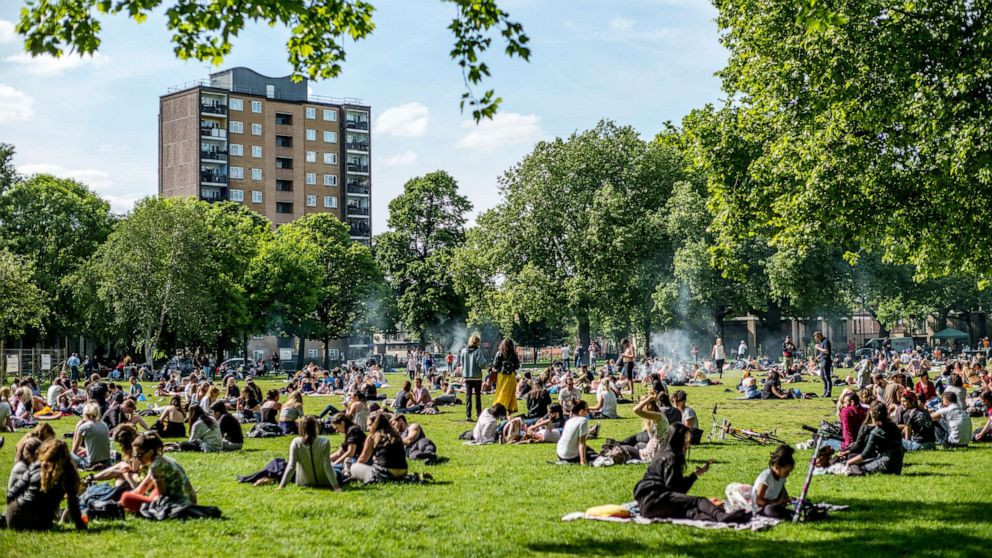 The city park as a place of collective interaction. Photo: Roy James Shakespeare/Getty Images
The city park as a place of collective interaction. Photo: Roy James Shakespeare/Getty Images
A continuation of the idea of neighborhood spaces is the concept of a 15-minute city, which was developed by Carlos Moreno. According to the concept, each district or microdistrict has basic social functions for life and work, and residents do not need to constantly go to the center. Its goal is to reduce carbon dioxide emissions and decentralize the urban governance model, where achieving the concept means:
- providing easy access to basic amenities — food, medical care;
- landscaping areas to ensure everyone has access to the natural environment and clean air;
- creating small office facilities, coworking spaces, and retail stores so that more people can work closer to home or online;
- building microdistricts with different types of housing and levels of accessibility;
- creating pedestrian and bicycle corridors to reduce the convenience of traveling by car;
- providing urban spaces and facilities with dual-purpose status (library — coworking, schoolyard — Sunday fair) in order to maximize the impact of infrastructure and promote wider community engagement in local events and activities.
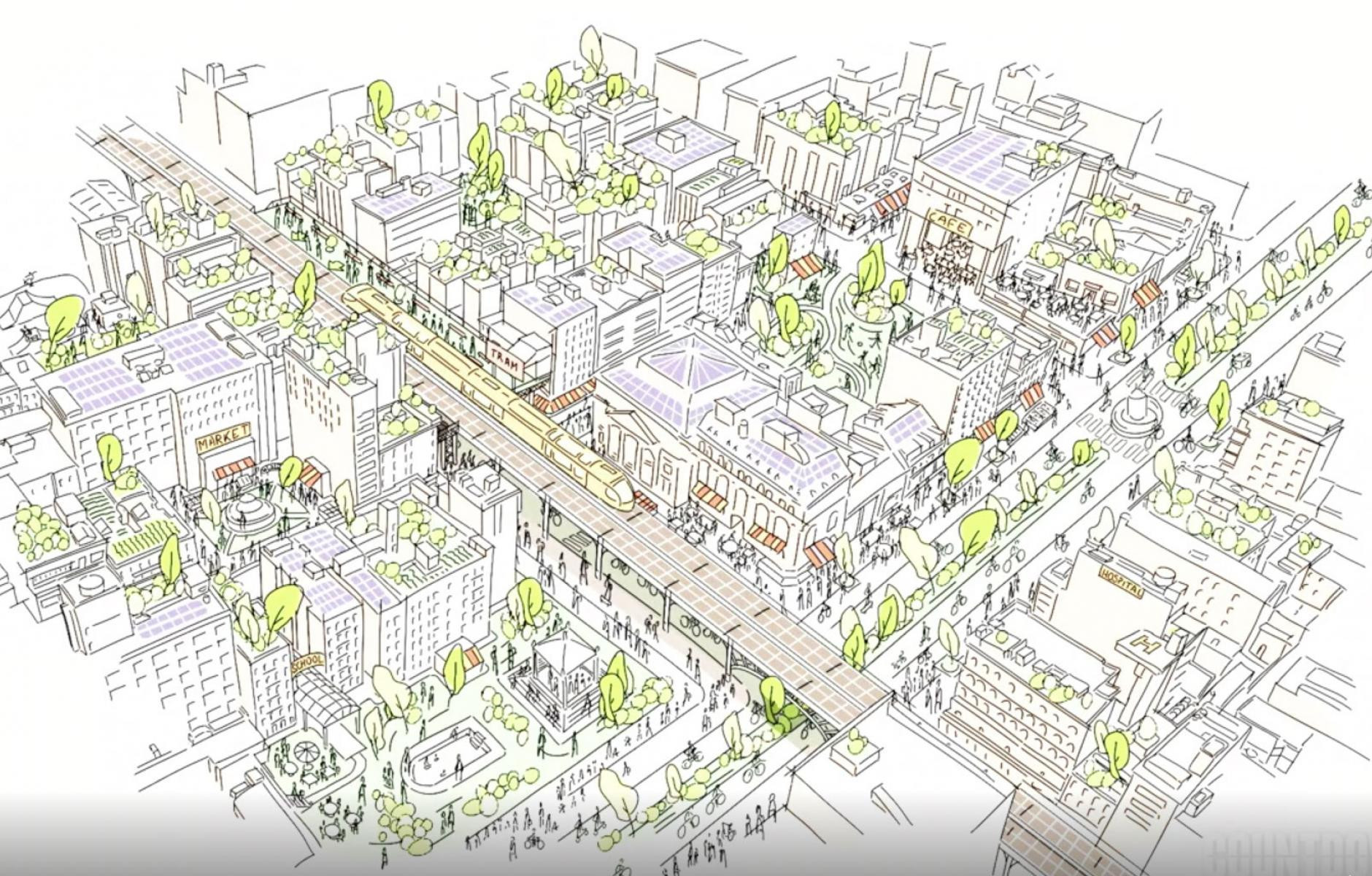 The concept of a 15-minute city. Image: Robert Steuteville/Public square
The concept of a 15-minute city. Image: Robert Steuteville/Public square
These approaches show us that urban life within neighborhoods is not limited to housing. For citizens, it is necessary to provide some conditions to make the territory convenient, accessible, economically and socially sustainable. Below, we invite you to discuss the forms of urban space organization that will motivate people to interact.
Urban cities and superblocks as tools for uniting the community
In 2016, Barcelona set itself the task of rethinking the look of a part of the city by developing a system of superblocks. Each of them consists of 9 blocks, some streets of which have become pedestrian zones. The aim of superblocking is to create a greener, fairer, and safer public space that will facilitate community interaction, the emergence of new partnerships between residents and the intensification of meetings between neighbors. Thus, children receive playgrounds, adults — places for recreation and communication, cyclists — special bicycle paths and significantly lower car traffic. Moreover, even business benefits from this because the absence of barriers to pedestrian traffic increases the commercial visibility of institutions.
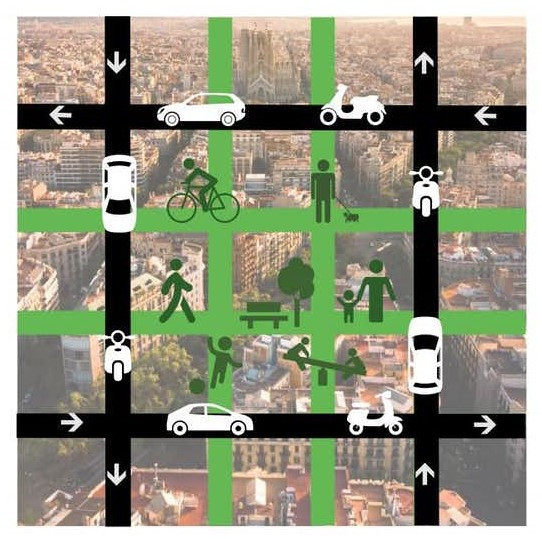 Superblock model in Barcelona. Image: Regenerative Design World
Superblock model in Barcelona. Image: Regenerative Design World
The superblock model also encourages social cohesion and collaboration through the opening of small local businesses and the creation of new jobs. At the same time, it is necessary to avoid monoculture activities, that is, in addition to restaurants, to support the development of other businesses in order to be able to provide for other needs of residents. This approach allows providing jobs to people with different professions, which affects the business diversity of the district and allows its economy to be more sustainable.
This initiative has been in operation for 6 years and has already shown positive results. Thus, the concentration of the most common air pollutants, nitrogen oxide and suspended solids, decreased by 25% and 17%, respectively. And all the Sant Antoni superblock residents interviewed said they felt more calm, safe, and socialized.
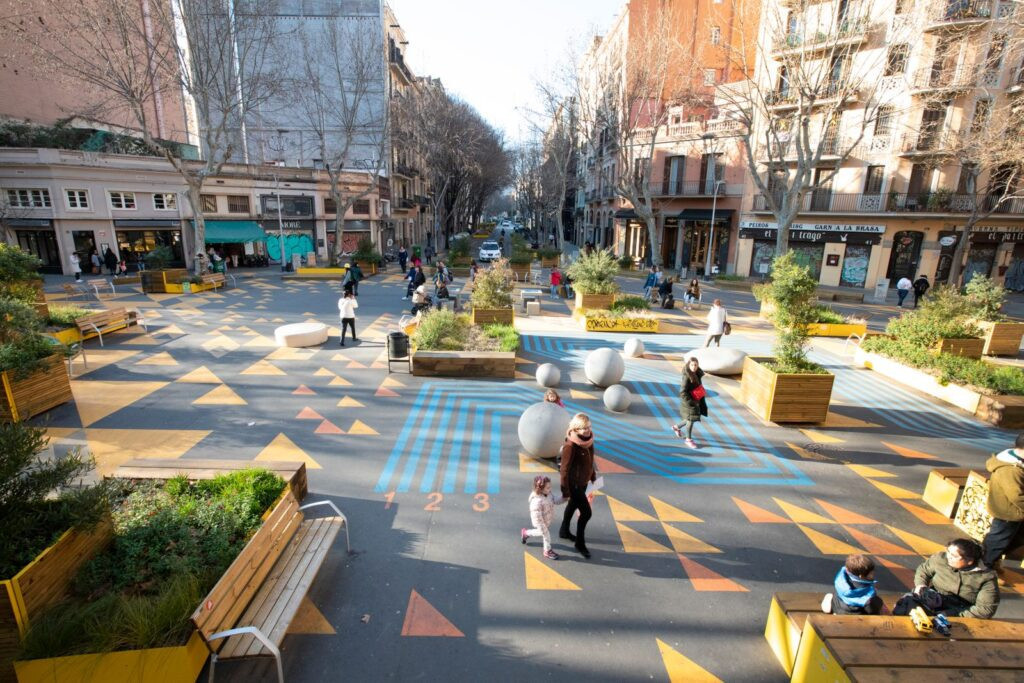 Comfortable public space for children and adults as a must-have element of the Superblock in Barcelona. Photo: Regenerative Design World
Comfortable public space for children and adults as a must-have element of the Superblock in Barcelona. Photo: Regenerative Design World
Another manifestation of community interaction for the sake of strengthening its economic and social interaction is the organization of urban gardens. In the Kuzguncuk microdistrict, in Istanbul, there is such a space. Residents have fought for their right to the green zone for 20 years, while the authorities wanted to use this land for profitable construction. Active citizens of Kuzguncuk mobilized their resources and established the Residents Association to coordinate actions, represent the community, and draw attention to the problem of politicians and the media. Eventually, in 2015, an urban garden was opened on the area of 2,000 square meters.
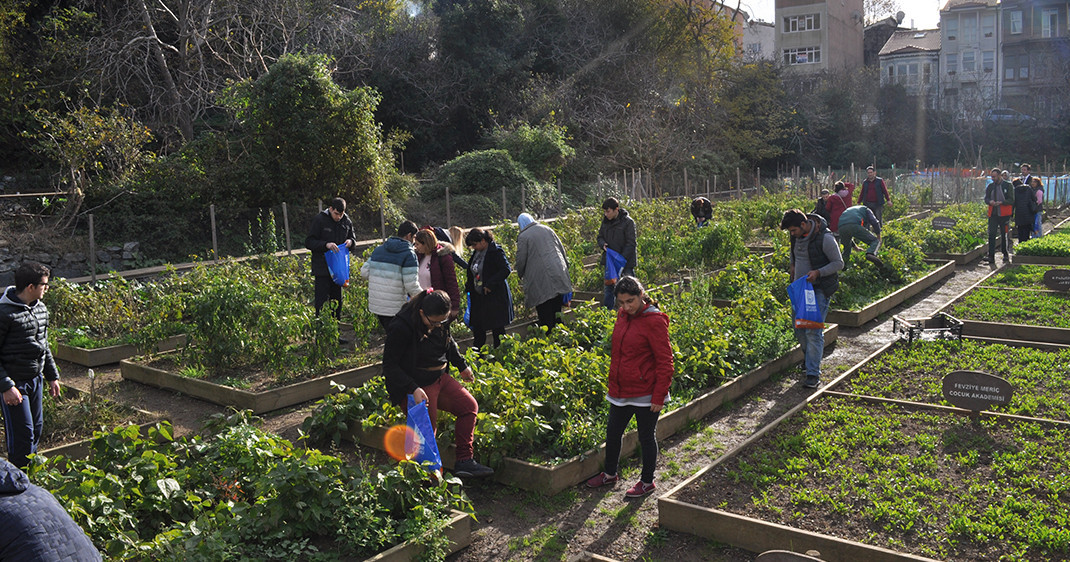 Urban city in Kuzguncuk microdistrict. Photo: Municipality of Uskudar
Urban city in Kuzguncuk microdistrict. Photo: Municipality of Uskudar
The territory is divided into 200 plots: 100 are distributed to residents through random public draws, and the other 100 — to private schools. The city not only brought practical benefits to individual residents, but also became a central place for the neighborhood. Community members meet there, cultural events take place. The survey showed that 42 out of 60 respondents consider the city as an open green space within the district, and only 10 visit it due to the presence of their own beds. As you can see, the city has become not only a place of food security for some residents, but also an area where social ties between the community are intensifying.
Lessons and opportunities for Ukraine
The forms and concepts of urban space organization in microdistricts described above will help increase the economic and social sustainability of communities. Somewhere these approaches cover a significant area of urban life, somewhere separate territories, such as green areas or urban gardens. The reconstruction of human-oriented microdistricts and neighborhood spaces in Ukraine will provide numerous benefits. The Transparent Cities program defined them as follows:
-
Efficient urban space planning
The focus on neighborhoods and microdistricts as the foundations of urban life requires a revision of planning and zoning rules. People need not only housing, but also green areas, playgrounds, places for weekly fairs or local businesses. Thus, municipal authorities can increase the minimum height or minimum depth of the first floors of new buildings to provide for their active use by commercial buildings. In addition, cities can facilitate the reuse of existing buildings or territories by weakening regulations that make it difficult to repurpose buildings. For example, in Los Angeles, neglected commercial buildings were allowed to be converted into living spaces, and in Rotterdam, an abandoned indoor pool began to be used as a working and concert space.
-
Decentralization of urban life
If the neighborhood and its residents are the backbone of urban planning, critical public services, infrastructure, and green spaces will become more accessible. The need to leave your neighborhood to buy groceries, visit a doctor, or walk around the park will be significantly reduced because people can get all of this within walking distance from home. Thus, in Vancouver, city zoning policies were updated back in 2018 to include the clause that large buildings should have food stores and urban beds.
-
Economic sustainability of local communities
Barcelona's experience shows that the formation of neighborhood spaces for people also contributes to improving the conditions for doing business. Superblocks have made the space for people comfortable and such that one can stay in for a long time. And this expanded the circle of potential buyers in stores or café visitors. In addition, the authorities can stimulate the economic sustainability of communities not only through the formation of pedestrian spaces, but also through the creation of appropriate mechanisms for supporting ultra-local businesses. For example, in Paris, the Semaest semi-state agency has the right to buy abandoned stores first, which it then leases at a price lower than the market price to priority types of local stores (from bakeries to bookstores).
-
Increase in the social capital of residents
The presence of human-oriented spaces within districts and microdistricts gives residents the opportunity to get to know each other better and establish contacts with each other. They begin to identify themselves as representatives of a particular community. In addition, solving local problems becomes faster because it is easier for people to get along and determine the goals they want to achieve.
-
Integration of displaced persons into the new social and economic space
The war in Ukraine led to 6.5 million people being internally displaced, of whom not everyone will want or be able to return to their homes. Using a good-neighborly approach will allow these people to integrate more quickly into the host community. Thus, green open zones will give IDPs more opportunities to get to know their neighbors, and the understanding that local business is possible and real — to open or relocate their own business.
The organization of life in small districts affects cities more than it may seem at first glance. Everything that happens within this territory affects the everyday life of citizens. There, community representatives learn to interact with each other, and also unite to overcome problems, challenges, and threats. So, if we want to build cities for people, we have to make neighborhoods the foundation of the city, and life in them — convenient and affordable. And this will be the basis for building both qualitatively new cities and a qualitatively new civil society.
Blog was prepared by Transparent Cities analyst Viktoriia Onyshchenko, co-authored with the program manager Olena Ogorodnik